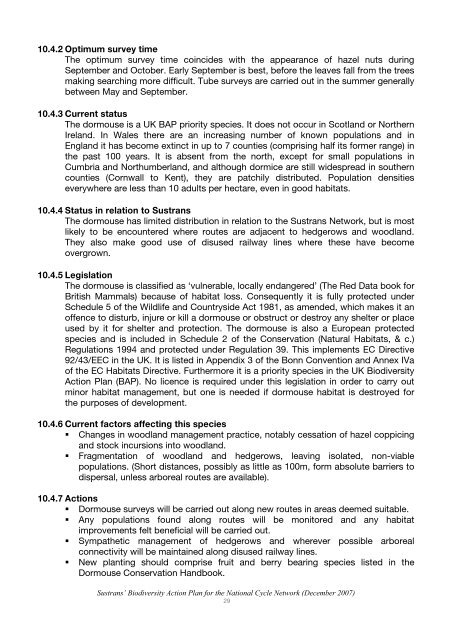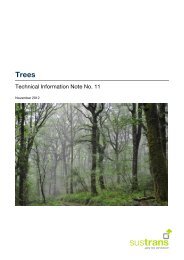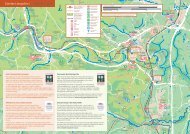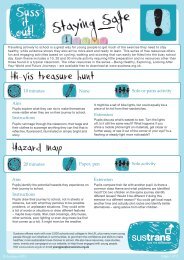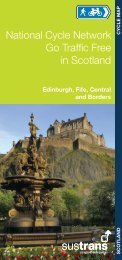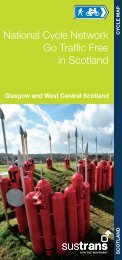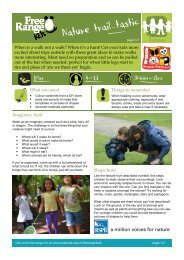Biodiversity Action Plan for the National Cycle Network ... - Sustrans
Biodiversity Action Plan for the National Cycle Network ... - Sustrans
Biodiversity Action Plan for the National Cycle Network ... - Sustrans
Create successful ePaper yourself
Turn your PDF publications into a flip-book with our unique Google optimized e-Paper software.
10.4.2 Optimum survey time<br />
The optimum survey time coincides with <strong>the</strong> appearance of hazel nuts during<br />
September and October. Early September is best, be<strong>for</strong>e <strong>the</strong> leaves fall from <strong>the</strong> trees<br />
making searching more difficult. Tube surveys are carried out in <strong>the</strong> summer generally<br />
between May and September.<br />
10.4.3 Current status<br />
The dormouse is a UK BAP priority species. It does not occur in Scotland or Nor<strong>the</strong>rn<br />
Ireland. In Wales <strong>the</strong>re are an increasing number of known populations and in<br />
England it has become extinct in up to 7 counties (comprising half its <strong>for</strong>mer range) in<br />
<strong>the</strong> past 100 years. It is absent from <strong>the</strong> north, except <strong>for</strong> small populations in<br />
Cumbria and Northumberland, and although dormice are still widespread in sou<strong>the</strong>rn<br />
counties (Cornwall to Kent), <strong>the</strong>y are patchily distributed. Population densities<br />
everywhere are less than 10 adults per hectare, even in good habitats.<br />
10.4.4 Status in relation to <strong>Sustrans</strong><br />
The dormouse has limited distribution in relation to <strong>the</strong> <strong>Sustrans</strong> <strong>Network</strong>, but is most<br />
likely to be encountered where routes are adjacent to hedgerows and woodland.<br />
They also make good use of disused railway lines where <strong>the</strong>se have become<br />
overgrown.<br />
10.4.5 Legislation<br />
The dormouse is classified as ‘vulnerable, locally endangered’ (The Red Data book <strong>for</strong><br />
British Mammals) because of habitat loss. Consequently it is fully protected under<br />
Schedule 5 of <strong>the</strong> Wildlife and Countryside Act 1981, as amended, which makes it an<br />
offence to disturb, injure or kill a dormouse or obstruct or destroy any shelter or place<br />
used by it <strong>for</strong> shelter and protection. The dormouse is also a European protected<br />
species and is included in Schedule 2 of <strong>the</strong> Conservation (Natural Habitats, & c.)<br />
Regulations 1994 and protected under Regulation 39. This implements EC Directive<br />
92/43/EEC in <strong>the</strong> UK. It is listed in Appendix 3 of <strong>the</strong> Bonn Convention and Annex IVa<br />
of <strong>the</strong> EC Habitats Directive. Fur<strong>the</strong>rmore it is a priority species in <strong>the</strong> UK <strong>Biodiversity</strong><br />
<strong>Action</strong> <strong>Plan</strong> (BAP). No licence is required under this legislation in order to carry out<br />
minor habitat management, but one is needed if dormouse habitat is destroyed <strong>for</strong><br />
<strong>the</strong> purposes of development.<br />
10.4.6 Current factors affecting this species<br />
Changes in woodland management practice, notably cessation of hazel coppicing<br />
and stock incursions into woodland.<br />
Fragmentation of woodland and hedgerows, leaving isolated, non-viable<br />
populations. (Short distances, possibly as little as 100m, <strong>for</strong>m absolute barriers to<br />
dispersal, unless arboreal routes are available).<br />
10.4.7 <strong>Action</strong>s<br />
Dormouse surveys will be carried out along new routes in areas deemed suitable.<br />
Any populations found along routes will be monitored and any habitat<br />
improvements felt beneficial will be carried out.<br />
Sympa<strong>the</strong>tic management of hedgerows and wherever possible arboreal<br />
connectivity will be maintained along disused railway lines.<br />
New planting should comprise fruit and berry bearing species listed in <strong>the</strong><br />
Dormouse Conservation Handbook.<br />
<strong>Sustrans</strong>’ <strong>Biodiversity</strong> <strong>Action</strong> <strong>Plan</strong> <strong>for</strong> <strong>the</strong> <strong>National</strong> <strong>Cycle</strong> <strong>Network</strong> (December 2007)<br />
29


